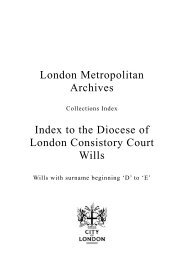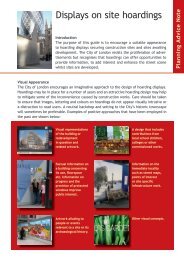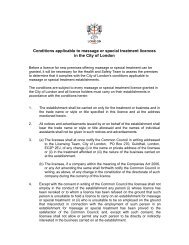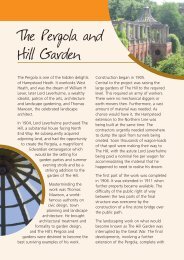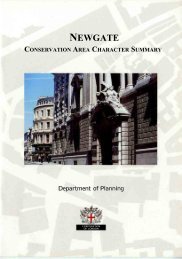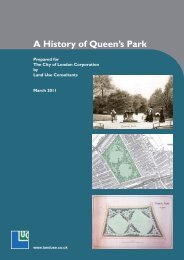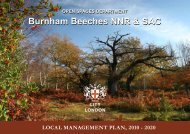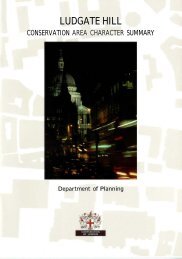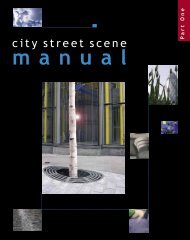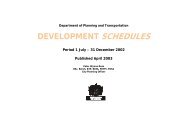Trail 2 Postman's Park and surrounding gardens - the City of London ...
Trail 2 Postman's Park and surrounding gardens - the City of London ...
Trail 2 Postman's Park and surrounding gardens - the City of London ...
Create successful ePaper yourself
Turn your PDF publications into a flip-book with our unique Google optimized e-Paper software.
<strong>Trail</strong> 2 Postman’s <strong>Park</strong> <strong>and</strong> <strong>surrounding</strong> <strong>gardens</strong><br />
leads onto ano<strong>the</strong>r area <strong>of</strong> raised beds<br />
containing shrubs <strong>and</strong> bedding plants with<br />
benches shaded under <strong>the</strong> canopy <strong>of</strong><br />
<strong>London</strong> Plane trees.<br />
At <strong>the</strong> far end <strong>of</strong> Noble<br />
Street is <strong>the</strong> Noble Street<br />
wild flower garden 8 with<br />
remains <strong>of</strong> a Roman Fort<br />
which dates from AD100.<br />
This area has been sown<br />
with wild flowers to<br />
encourage a variety <strong>of</strong><br />
wildlife. On <strong>the</strong> opposite<br />
side <strong>of</strong> <strong>the</strong> road is <strong>the</strong><br />
churchyard <strong>of</strong> St Olave,<br />
Silver Street 9 . The church<br />
itself was destroyed in <strong>the</strong><br />
Great Fire <strong>of</strong> 1666. Robinia,<br />
oak <strong>and</strong> o<strong>the</strong>r trees provide a<br />
contrast to <strong>the</strong> straight lines<br />
<strong>of</strong> <strong>the</strong> modern buildings that<br />
surround it.<br />
The ruins at<br />
Noble Street<br />
St Olave Silver Street<br />
Garden<br />
Retrace your steps South, back down<br />
Noble Street <strong>and</strong> <strong>the</strong>n turn left down Oat<br />
Lane which will lead you to <strong>the</strong> small<br />
garden <strong>of</strong> St Mary Staining 10 .<br />
Continue down <strong>the</strong> steps<br />
through St Alban’s Court, an<br />
alleyway underneath <strong>the</strong><br />
building, which will<br />
bring you to <strong>the</strong> Tower<br />
<strong>of</strong> St Alban. Walk<br />
down Love Lane to<br />
<strong>the</strong> historic<br />
churchyard <strong>of</strong> St Mary<br />
Aldermanbury 11 .<br />
Herbaceous borders<br />
surround <strong>the</strong> statue <strong>of</strong><br />
Shakespeare. Fellow<br />
actors John Hemynge<br />
<strong>and</strong> Henry Condell, are St Mary Aldermanbury<br />
Garden<br />
also commemorated, it<br />
is to <strong>the</strong>m that we owe <strong>the</strong> printing <strong>of</strong> <strong>the</strong><br />
First Folio <strong>of</strong> Shakespeare’s work.<br />
Walking down Aldermanbury past <strong>the</strong><br />
Guildhall Library will bring you to<br />
St Lawrence Jewry 12 . The church was<br />
built in 1136 over a tiered section <strong>of</strong> <strong>the</strong><br />
Roman Amphi<strong>the</strong>atre. It received its suffix,<br />
‘Jewry’, from <strong>the</strong> fact that<br />
it was sited at <strong>the</strong> edge <strong>of</strong><br />
<strong>the</strong> medieval <strong>City</strong>’s Jewish<br />
area. The wea<strong>the</strong>rvane on<br />
top <strong>of</strong> <strong>the</strong> spire is from<br />
Wren’s original church,<br />
which was mostly<br />
destroyed during <strong>the</strong> Wea<strong>the</strong>r vane at<br />
Blitz, but was re-built by St Lawrence Jewry<br />
Cecil Brown, closely following Wren’s<br />
original design.<br />
St Mary Staining Garden<br />
Continue down Milk Street<br />
turning right onto<br />
Cheapside. You will find<br />
St Paul’s underground<br />
station 13 where<br />
<strong>the</strong> road meets<br />
New Change <strong>and</strong> <strong>the</strong><br />
trail ends.<br />
The <strong>gardens</strong> in <strong>the</strong> <strong>City</strong> are part <strong>of</strong> a network <strong>of</strong><br />
open spaces, parks <strong>and</strong> <strong>gardens</strong> around <strong>London</strong>,<br />
owned <strong>and</strong> managed by <strong>the</strong> <strong>City</strong> <strong>of</strong> <strong>London</strong> as<br />
part <strong>of</strong> its commitment to sustaining a world<br />
class city. Each open space is a unique resource<br />
managed for <strong>the</strong> use <strong>and</strong> enjoyment <strong>of</strong> <strong>the</strong><br />
public <strong>and</strong> for <strong>the</strong> conservation <strong>of</strong> wildlife <strong>and</strong><br />
historic l<strong>and</strong>scape. A full list <strong>of</strong> sites <strong>and</strong> visitor<br />
information can be found on our website at:<br />
www.city<strong>of</strong>london.gov.uk/openspaces or<br />
by contacting <strong>the</strong> Open Spaces Directorate on<br />
020 7332 3505.<br />
St Paul’s Garden<br />
CITY GARDENS<br />
For fur<strong>the</strong>r information <strong>and</strong> opening<br />
times please contact:<br />
The <strong>City</strong> Gardens Office<br />
P.O. Box 270, Guildhall,<br />
<strong>London</strong> EC2P 2EJ<br />
Tel: 020 7374 4127 Fax: 020 7710 8524<br />
E-mail: parks.<strong>gardens</strong>@city<strong>of</strong>london.gov.uk<br />
Whilst in <strong>the</strong> <strong>City</strong> Gardens do not hesitate to<br />
approach any <strong>of</strong> our staff, who will be<br />
happy to assist you.<br />
If you require this leaflet in<br />
ano<strong>the</strong>r format please contact<br />
020 7332 3505<br />
PRINTED USING VEGETABLE BASED<br />
INKS ON PAPER MADE FROM 100%<br />
POST-CONSUMER WASTE<br />
<strong>Trail</strong> 2:<br />
Postman’s <strong>Park</strong> <strong>and</strong><br />
<strong>surrounding</strong> <strong>gardens</strong><br />
CITY GARDENS WALKS
<strong>Trail</strong> 2<br />
Postman’s <strong>Park</strong><br />
<strong>and</strong> <strong>surrounding</strong><br />
<strong>gardens</strong><br />
Start point Barbican Underground Station<br />
End Point St Paul’s Underground Station<br />
Distance 2.4km (1.5 miles)<br />
Approx. time 1 hour<br />
EST SMITHFIELD<br />
HILL<br />
CHARTERHOUSE STREET<br />
Smithfield Market<br />
West<br />
Smithfield<br />
Holy<br />
Sepulchre<br />
without<br />
Newgate<br />
3<br />
4<br />
LUDG<br />
OLD BAILEY<br />
2<br />
G I LTSPUR ST<br />
Christchurch<br />
Greyfriars<br />
NEWGATE STREET<br />
Warwick<br />
Square<br />
Gardens<br />
LONG LANE<br />
LITTLE BRITAIN<br />
St<br />
Bartholomew’ s<br />
Hospital<br />
Barbican<br />
1<br />
St<br />
Bartholomew<br />
<strong>the</strong> Great<br />
5<br />
KING EDWARD ST<br />
St Paul's<br />
Postmans<br />
<strong>Park</strong><br />
Noble<br />
Street<br />
Gardens<br />
BEECH STREET<br />
The Barbican<br />
Barber Surgeons<br />
& Baston House<br />
LONDON WALL<br />
St Olave<br />
Silver Street<br />
Aldermanbury<br />
Gardens<br />
Begin at Barbican underground station<br />
S<br />
1S<br />
by turning right <strong>and</strong> walking down<br />
Long Lane S towards Smithfield Market, a<br />
Grade II Victorian listed building. In this<br />
C<br />
area meat has been bought <strong>and</strong> sold for<br />
over 800 years. West Smithfield 2<br />
garden on <strong>the</strong> left was once a meeting<br />
place used for jousts, tournaments <strong>and</strong><br />
6<br />
ALDERSGATE STREET<br />
MONTAGUE ST<br />
13<br />
ST MARTIN'S LE-GRAND<br />
Museum<br />
<strong>of</strong><br />
<strong>London</strong><br />
NEW C<br />
8<br />
St Mary<br />
Staining<br />
St Anne &<br />
St Agnes<br />
7<br />
OAT LANE<br />
NOBLE STREET<br />
10<br />
9<br />
GRESHAM STREET<br />
WOOD STREET<br />
CHEAPSIDE<br />
12<br />
MILK STREET<br />
S<br />
St Alphage’<br />
Ga<br />
11<br />
ALDERMANBURY<br />
SILK<br />
Guild<br />
GRES<br />
M<br />
executions. In 1855 <strong>the</strong><br />
field was closed as a<br />
meeting place <strong>and</strong> it was<br />
turned into open space for<br />
<strong>the</strong> public in 1872.<br />
While you are walking<br />
around this part <strong>of</strong> <strong>London</strong><br />
you may see <strong>the</strong> <strong>City</strong>’s resident pair <strong>of</strong><br />
Peregrine Falcons who have nested <strong>and</strong><br />
raised <strong>the</strong>ir young in this area.<br />
Walk down West Smithfield following<br />
<strong>the</strong> road into Giltspur Street. Where<br />
Giltspur Street meets Newgate Street is <strong>the</strong><br />
Church <strong>of</strong> The Holy Sepulchre without<br />
Newgate M 3 . The church was made<br />
famous in <strong>the</strong> old nursery rhyme ‘oranges<br />
<strong>and</strong> lemons’ in which St Sepulchre’s bells<br />
S<br />
were <strong>the</strong> ‘bells <strong>of</strong> Old Bailey’.<br />
‘Agapanthus’ in bloom at<br />
<strong>the</strong> Old Bailey<br />
West Smithfield in<br />
Spring<br />
On <strong>the</strong> opposite side P<br />
<strong>of</strong> <strong>the</strong> road are <strong>the</strong> new<br />
<strong>gardens</strong> <strong>of</strong> <strong>the</strong> Old<br />
Bailey 4 . Relax with<br />
<strong>the</strong> sound <strong>of</strong> <strong>the</strong> gentle<br />
fountains, sheltered by<br />
<strong>the</strong> Yew hedging <strong>and</strong><br />
<strong>London</strong> Plane trees<br />
(Platanus x acerifolia).<br />
Continue along Newgate Street, towards<br />
King Edward Street. Cross over <strong>the</strong> road at<br />
Newgate Street Traffic Isl<strong>and</strong>, once a<br />
bare brick wall now a beautiful feature –<br />
with Clematis, Trachelospermum<br />
jasminoides <strong>and</strong> Actinidia kolomikta,<br />
growing up stainless steel wires with a<br />
winter-flowering iris planted underneath.<br />
On <strong>the</strong> corner <strong>of</strong> <strong>the</strong>se<br />
two roads lies<br />
Christchurch Greyfriars<br />
5 . It is a Wren church<br />
that was bombed in<br />
World War II. The rose<br />
garden beds sit where<br />
<strong>the</strong> original pews would<br />
have been, while <strong>the</strong> 10 Christchurch Greyfriars<br />
tall wooden towers<br />
represent <strong>the</strong> pillars which would have once<br />
held <strong>the</strong> ro<strong>of</strong>. Today Clematis <strong>and</strong> climbing<br />
roses weave <strong>the</strong>ir way up <strong>the</strong> pillars.<br />
The Watts Memorial,<br />
A Postman’s <strong>Park</strong><br />
Exit <strong>the</strong> garden on King<br />
Edward Street <strong>and</strong><br />
continue up <strong>the</strong> road.<br />
On <strong>the</strong> right h<strong>and</strong> side<br />
you will see a gate<br />
under a large <strong>London</strong><br />
Plane tree (Platanus x<br />
hispanica), walk through<br />
it to Postman’s <strong>Park</strong> 6 .<br />
Opened in 1880 it is made up <strong>of</strong> <strong>the</strong><br />
churchyards <strong>of</strong> St Leonards, Foster Lane,<br />
St Botolph, Aldersgate <strong>and</strong> <strong>the</strong> graveyard<br />
<strong>of</strong> Christchurch, Newgate Street. The park<br />
acquired its name due to its popularity as<br />
a lunchtime garden with workers from <strong>the</strong><br />
nearby old General Post Office. It is home<br />
to <strong>the</strong> famous Watts memorial, built in<br />
1900 by Victorian painter <strong>and</strong> philanthropist<br />
King Edward Street<br />
Watts<br />
Memorial<br />
Little Britain<br />
H<strong>and</strong>kerchief<br />
tree<br />
Plan <strong>of</strong> Postman’s <strong>Park</strong><br />
GF Watts (1817-1904). It was made to<br />
commemorate heroic acts by ‘everyday<br />
men <strong>and</strong> women’ who had given <strong>the</strong>ir<br />
lives attempting to save o<strong>the</strong>rs. A sight to<br />
behold in late spring is <strong>the</strong> H<strong>and</strong>kerchief<br />
Tree, Davidia Involucrata, in full bloom. It<br />
was given its name because its flowers<br />
look like pocket h<strong>and</strong>kerchiefs.<br />
Exit Postman’s park<br />
past <strong>the</strong> fountain <strong>and</strong><br />
fish pond. Turn right <strong>and</strong><br />
walk along Aldersgate<br />
Street, <strong>the</strong>n bear left<br />
onto Gresham Street.<br />
Here you will find <strong>the</strong><br />
garden <strong>of</strong> St Anne <strong>and</strong> St Agnes<br />
7 . Wren constructed <strong>the</strong><br />
church in 1690, it suffered<br />
some damage during<br />
<strong>the</strong> Second World<br />
War, but it was<br />
restored between<br />
1963–68. The<br />
small grassed<br />
garden in front<br />
<strong>of</strong> <strong>the</strong> church<br />
Aldersgate Street<br />
St Anne <strong>and</strong> St Agnes Garden<br />
Clematis at Newgate Street trafficisl<strong>and</strong>



